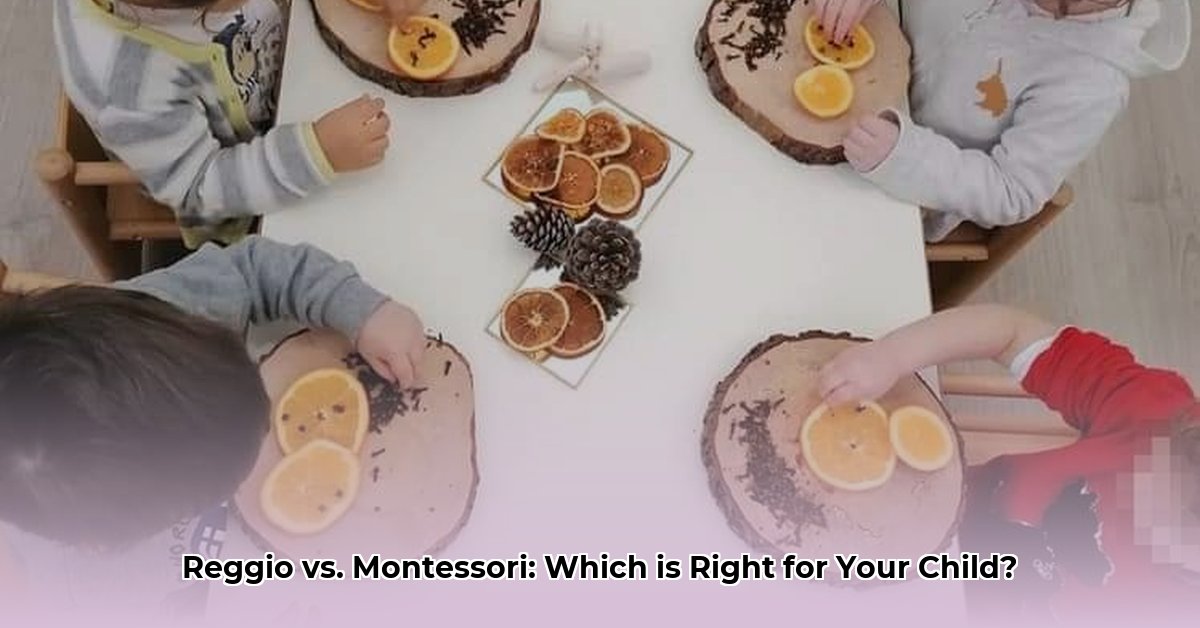Choosing a preschool is a big decision! Two popular approaches, Reggio Emilia and Montessori, offer enriching experiences, but differ significantly. This guide provides a clear comparison, empowering you to choose the best fit for your child and family.
Understanding Reggio Emilia and Montessori
Both approaches are child-centered, but their philosophies and classroom implementations diverge. Let’s explore the core differences:
Reggio Emilia: The Child as Explorer
Imagine a vibrant art studio filled with natural light and intriguing materials. This is the essence of a Reggio Emilia classroom, where children are seen as capable, curious explorers.
- Emergent Curriculum: The curriculum isn’t pre-planned; it evolves based on children’s interests. A child’s fascination with butterflies might lead to projects involving art, science, storytelling, and music.
- The Hundred Languages: Children are encouraged to express themselves through various “languages,” including drawing, painting, building, dramatic play, and music.
- The Teacher as Guide: Teachers act as facilitators, nurturing children’s explorations and documenting their learning journeys.
- The Environment as the Third Teacher: The classroom is designed to be inspiring and adaptable, fostering creativity and collaboration.
Montessori: The Child as Independent Learner
Picture a meticulously organized classroom with shelves filled with specialized materials. This is the hallmark of a Montessori environment, where independence and self-directed learning are paramount.
- Prepared Environment: The classroom is carefully structured with materials designed to engage children’s senses and promote self-discovery.
- Self-Correcting Materials: Many Montessori materials allow children to identify and correct their own mistakes, fostering independence and problem-solving skills.
- The Teacher as Observer: Teachers observe children’s progress, offering guidance and introducing new concepts when needed.
- Focus on Practical Skills: Children learn practical life skills, such as pouring, buttoning, and setting the table, alongside academics.
Side-by-Side Comparison: Reggio Emilia vs. Montessori
| Feature | Reggio Emilia | Montessori |
|---|---|---|
| Philosophy | Child-centered, emergent curriculum | Self-directed learning, prepared environment |
| Teacher’s Role | Facilitator, co-learner, mentor, documenter | Observer, guide, facilitator |
| Classroom | Flexible, aesthetically rich, atelier-style | Structured, organized, specific learning areas |
| Learning Style | Collaborative, project-based, exploratory | Independent, individualized, self-paced |
| Materials | Varied, open-ended, adaptable | Specialized manipulatives, structured materials |
| Age Grouping | Typically same age | Mixed-age groups (often 3-year spans) |
| Technology Use | Integrated thoughtfully; documentation, creativity | Often minimized, particularly with younger children |
| Cost | Often higher; specialized resources & lower ratios | Varies; potentially more affordable in some areas |
| Availability | Less common than traditional or Montessori programs | More widely available |
| Best Suited For… | Creative, social, collaborative learners | Independent, self-motivated, hands-on learners |
Which Approach is Right for Your Child?
There’s no single “best” approach. The ideal choice depends on your child’s individual needs and your family’s values.
Consider these questions:
- Does your child thrive in collaborative settings or prefer independent exploration?
- Is your child highly creative and expressive, or are they drawn to structured activities?
- Do you value open-ended exploration or a more sequential learning approach?
Visiting potential preschools is crucial. Observe the classrooms, talk with teachers, and envision your child in that setting.
Practical Considerations
- Cost: Both Reggio Emilia and Montessori preschools can be more expensive than traditional preschools.
- Availability: Montessori schools are generally more readily available than Reggio Emilia programs.
- Incorporating Philosophies at Home: You can incorporate elements of both philosophies at home, even if you choose a different preschool setting. Provide open-ended materials for creative exploration and encourage independence through age-appropriate chores.
Conclusion
Choosing a preschool philosophy requires careful consideration of your child’s individual needs and your family’s values. Reggio Emilia and Montessori both provide enriching learning environments, but differ significantly in their approach. By understanding these differences and visiting potential schools, you can make an informed decision and select a preschool that sets your child on a path of lifelong learning.
Further Exploration
- North American Reggio Emilia Alliance (NAREA)
- The American Montessori Society (AMS)
- Association Montessori Internationale (AMI)
- National Association for the Education of Young Children (NAEYC)
This information is for general guidance only and does not constitute professional educational advice. Current research on early childhood education is always evolving, and it’s beneficial to stay informed about the latest findings. It’s important to consult with educators and conduct thorough research to make the best choice for your child.
- Water Mill Electricity Generator Provides Free Home Power - December 16, 2025
- Water Wheel Electric Generator Provides Free Home Electricity - December 15, 2025
- Choosing the Right Portable Hydro Turbine for Your Needs - December 14, 2025
















